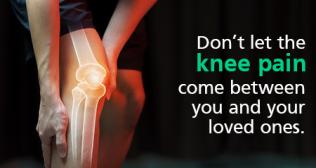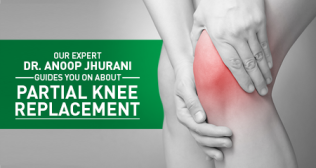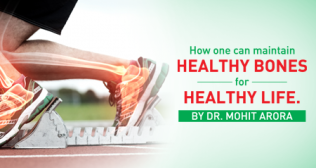
Orthopaedics
Forget Pain: Take A Big Leap
Forget Pain: Take A Big Leap Jul 19, 2014
 Back pain when caused by a problem in the sciatic nerve is known as sciatica. Sciatica describes the symptoms of leg pain and possibly tingling, numbness or weakness that originates in the lower back and travels through the buttock and down the large sciatic nerve in the back of the leg. When there’s some pressure or injury on the nerves forming the sciatica nerve, it causes pain in the lower back, which spreads to the buttocks and leg.
Most people who get sciatica are between the age group of 30 to 50 years. Women are more likely to develop the problem during pregnancy because of pressure on the sciatic nerve from the developing uterus. What usually sets sciatica apart is the way the pain radiates down the leg and into the foot. It may feel like a bad leg cramp that lasts for many days. The good news, however, is that up to 90 per cent of people recover without surgery.
Symptoms of sciatica
The symptoms of sciatica tend to appear suddenly and can last for days or weeks. The most common symptom is lower back pain that extends through the hip and buttock and down one leg. The pain usually affects one leg and may get worse when you sit, cough or sneeze. The leg may also feel numb, weak or tingly at times.
Causes of sciatica
Herniated disc: The most common cause of sciatica is a herniated disc. The discs act like cushions between the vertebrae of the spine. As you age, the discs get weaker and you become vulnerable to injury.
Spinal stenosis: Natural wear and tear of the vertebrae can lead to narrowing of the spinal canal. This is called spinal stenosis. It may put pressure on the roots of the sciatic nerve.
Spinal tumour: In rare cases, sciatica may result from tumours growing inside the spinal cord or sciatic nerve. As the tumour grows, it may put pressure on nerves that branch off from spinal cord.
A fat wallet: A fat wallet can trigger piriformis syndrome. The condition can affect men who keep their wallet in the back pocket of their pants. This can put chronic pressure on the piriformis muscle and can irritate the sciatic nerve over time.
Injury or infection: Other causes of sciatica include muscle inflammation, infection or a fracture.
Ways to get Relief
There are several steps you can take at home to get relief from the pain such as:
Ice and heat: A heating pad or ice pack may be very helpful. Apply the heat or ice for about 20 minutes every two hours.
Stretching: Try and remain active, while your sciatica is healing. Being in motion can actually help reduce inflammation and pain. A physiotherapist can show you how to stretch the hamstring and lower back.
Injections: In severe cases, a doctor may recommend injecting steroids into the spine area to reduce inflammation. It delivers the medication directly to the area around the sciatic nerve.
Surgery: If your sciatica is due to a herniated disk and is causing weakness in the limbs and severe pain even after four to six weeks, surgery may be an option.
The surgeon will remove a portion of the herniated disk to relieve the pressure on the sciatic nerve.
Back pain when caused by a problem in the sciatic nerve is known as sciatica. Sciatica describes the symptoms of leg pain and possibly tingling, numbness or weakness that originates in the lower back and travels through the buttock and down the large sciatic nerve in the back of the leg. When there’s some pressure or injury on the nerves forming the sciatica nerve, it causes pain in the lower back, which spreads to the buttocks and leg.
Most people who get sciatica are between the age group of 30 to 50 years. Women are more likely to develop the problem during pregnancy because of pressure on the sciatic nerve from the developing uterus. What usually sets sciatica apart is the way the pain radiates down the leg and into the foot. It may feel like a bad leg cramp that lasts for many days. The good news, however, is that up to 90 per cent of people recover without surgery.
Symptoms of sciatica
The symptoms of sciatica tend to appear suddenly and can last for days or weeks. The most common symptom is lower back pain that extends through the hip and buttock and down one leg. The pain usually affects one leg and may get worse when you sit, cough or sneeze. The leg may also feel numb, weak or tingly at times.
Causes of sciatica
Herniated disc: The most common cause of sciatica is a herniated disc. The discs act like cushions between the vertebrae of the spine. As you age, the discs get weaker and you become vulnerable to injury.
Spinal stenosis: Natural wear and tear of the vertebrae can lead to narrowing of the spinal canal. This is called spinal stenosis. It may put pressure on the roots of the sciatic nerve.
Spinal tumour: In rare cases, sciatica may result from tumours growing inside the spinal cord or sciatic nerve. As the tumour grows, it may put pressure on nerves that branch off from spinal cord.
A fat wallet: A fat wallet can trigger piriformis syndrome. The condition can affect men who keep their wallet in the back pocket of their pants. This can put chronic pressure on the piriformis muscle and can irritate the sciatic nerve over time.
Injury or infection: Other causes of sciatica include muscle inflammation, infection or a fracture.
Ways to get Relief
There are several steps you can take at home to get relief from the pain such as:
Ice and heat: A heating pad or ice pack may be very helpful. Apply the heat or ice for about 20 minutes every two hours.
Stretching: Try and remain active, while your sciatica is healing. Being in motion can actually help reduce inflammation and pain. A physiotherapist can show you how to stretch the hamstring and lower back.
Injections: In severe cases, a doctor may recommend injecting steroids into the spine area to reduce inflammation. It delivers the medication directly to the area around the sciatic nerve.
Surgery: If your sciatica is due to a herniated disk and is causing weakness in the limbs and severe pain even after four to six weeks, surgery may be an option.
The surgeon will remove a portion of the herniated disk to relieve the pressure on the sciatic nerve. 


















